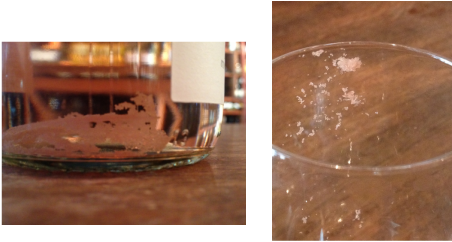Maybe you’ve had the last of a white wine bottle (or a rose) and found what looked like tiny shards of glass in it? Or maybe you’ve had a red with lot of dark crumblies in the bottom (as evidenced in the picture on the upper left, they can even form long, crusty chains that are sort of ring shaped in the bottom of the bottle.) I remember wine tasting once in college and being sure there was a fragment of stem in my glass (which, knowing what I know now, unless it was put there as a joke by the tasting room staff is pretty much impossible.) It was likely a decent sized chunk of sediment...
So, what is this sediment? Should you be worried? Should you return the bottle and demand a refund?
Relax.
These little crystals are tartrate salts (usually in the form of potassium bitartrate) and are likely the byproduct of tartaric acid additions early in the winemaking process. Acid is usually added in cases where the fruit is overly ripe or imbalanced in terms of sugar vs acid.
Tartrates are usually fully settled out of the wine before bottling by chilling the wine in a large stainless steel tank. The salts precipitate out due to the cold temperature and the wine is then removed, leaving the salts in the bottom of the tank. However, the solubility of tartrates is also affected by other components such as alcohol content. So sometimes not all of them successfully settle out. Or sometimes the winemaker may not have anticipated a need to cold-settle them to begin with (especially in red wines.) Then, depending on the temperature changes they experience in your house, in the fridge, the grocery store or the semi truck in which they were transported, those salts may become crystallized again and settle out into the bottom of your bottle.
They’re a little crunchy on your teeth, so you may choose to just toss out the dregs if you find them (or, if you're feeling fancy, use a decanter and leave the salts in the bottle,) but they won’t hurt you. And hey, if you find some and are curious, feel free to fish them out of the glass and give them a good crunch! Yum! (or at least “meh!”)
Did you know?
The beautiful photo on my homepage was taken in Beaune (which is in Burgundy) on my only trip to French wine country. It was back in 2007, before I'd really delved into this journey- I'd love to go back knowing what I know now!
So, what is this sediment? Should you be worried? Should you return the bottle and demand a refund?
Relax.
These little crystals are tartrate salts (usually in the form of potassium bitartrate) and are likely the byproduct of tartaric acid additions early in the winemaking process. Acid is usually added in cases where the fruit is overly ripe or imbalanced in terms of sugar vs acid.
Tartrates are usually fully settled out of the wine before bottling by chilling the wine in a large stainless steel tank. The salts precipitate out due to the cold temperature and the wine is then removed, leaving the salts in the bottom of the tank. However, the solubility of tartrates is also affected by other components such as alcohol content. So sometimes not all of them successfully settle out. Or sometimes the winemaker may not have anticipated a need to cold-settle them to begin with (especially in red wines.) Then, depending on the temperature changes they experience in your house, in the fridge, the grocery store or the semi truck in which they were transported, those salts may become crystallized again and settle out into the bottom of your bottle.
They’re a little crunchy on your teeth, so you may choose to just toss out the dregs if you find them (or, if you're feeling fancy, use a decanter and leave the salts in the bottle,) but they won’t hurt you. And hey, if you find some and are curious, feel free to fish them out of the glass and give them a good crunch! Yum! (or at least “meh!”)
Did you know?
The beautiful photo on my homepage was taken in Beaune (which is in Burgundy) on my only trip to French wine country. It was back in 2007, before I'd really delved into this journey- I'd love to go back knowing what I know now!

 RSS Feed
RSS Feed